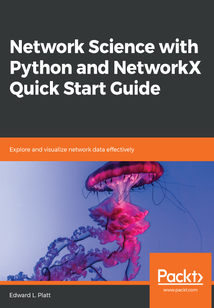舉報 

會員
Network Science with Python and NetworkX Quick Start Guide
NetworkXisaleadingfreeandopensourcepackageusedfornetworksciencewiththePythonprogramminglanguage.NetworkXcantrackpropertiesofindividualsandrelationships,findcommunities,analyzeresilience,detectkeynetworklocations,andperformawiderangeofimportanttasks.Withtherecentreleaseofversion2,NetworkXhasbeenupdatedtobemorepowerfulandeasytouse.Ifyou’readatascientist,engineer,orcomputationalsocialscientist,thisbookwillguideyouinusingthePythonprogramminglanguagetogaininsightsintoreal-worldnetworks.Startingwiththefundamentals,you’llbeintroducedtothecoreconceptsofnetworkscience,alongwithexamplesthatusereal-worlddataandPythoncode.Thisbookwillintroduceyoutotheoreticalconceptssuchasscale-freeandsmall-worldnetworks,centralitymeasures,andagent-basedmodeling.You’llalsobeabletolookforscale-freenetworksinrealdataandvisualizeanetworkusingcircular,directed,andshelllayouts.Bytheendofthisbook,you’llbeabletochooseappropriatenetworkrepresentations,useNetworkXtobuildandcharacterizenetworks,anduncoverinsightswhileworkingwithreal-worldsystems.
目錄(144章)
倒序
- coverpage
- Title Page
- Copyright and Credits
- Network Science with Python and NetworkX Quick Start Guide
- Dedication
- About Packt
- Why subscribe?
- Packt.com
- Contributors
- About the author
- About the reviewer
- Packt is searching for authors like you
- Preface
- Who this book is for
- What this book covers
- To get the most out of this book
- Download the example code files
- Conventions used
- Get in touch
- Reviews
- What is a Network?
- Network science
- The history of network science
- Network science today
- What is a network?
- Nodes and edges
- Visualizing networks
- What is NetworkX?
- Types of networks
- Directed networks
- Weighted networks
- Understanding edges
- Social networks
- Flow networks
- Similarity networks
- Spatial networks
- Your first network in NetworkX
- Summary
- References
- Working with Networks in NetworkX
- The Graph class – undirected networks
- Adding attributes to nodes and edges
- Adding edge weights
- The DiGraph class – when direction matters
- MultiGraph and MultiDiGraph – parallel edges
- Summary
- References
- From Data to Networks
- Modeling your data
- Reading and writing network files
- Creating a network with code
- Summary
- References
- Affiliation Networks
- Nodes and affiliations
- Affiliation networks in NetworkX
- Projections
- Summary
- References
- The Small Scale - Nodes and Centrality
- Centrality – finding key nodes
- Bridges brokers and bottlenecks – betweenness centrality
- Hubs – eigenvector centrality
- Closeness centrality
- Local clustering
- Summary
- References
- The Big Picture - Describing Networks
- The global structure of networks
- Datasets
- Diameter and mean shortest path
- Global clustering
- Measuring resilience
- Minimum cuts
- Connectivity
- Centralization and inequality
- Summary
- References
- In-Between - Communities
- Communities – networks within networks
- Community detection in NetworkX
- Modularity maximization
- Visualizing
- An online social network
- Girvan-Newman – betweenness-based communities
- Cliques
- K-cores
- Summary
- References
- Social Networks and Going Viral
- Social networks
- Strong and weak ties
- Tie strength
- Bridge span
- Comparing strength and span
- The small world problem
- Ring networks
- A real social network
- Random networks
- Watts-Strogatz networks
- Contagion – how things spread
- Simple contagion
- Complex contagion
- Summary
- References
- Simulation and Analysis
- Watts-Strogatz and small worlds
- Preferential attachment and heavy-tailed networks
- Configuration models
- Agent-based models
- Summary
- References
- Networks in Space and Time
- Locations and events
- Networks in space
- Gravity models
- Working with spatial data
- Gravity model for air travel
- Residual network
- Network properties
- Networks in time
- Layered networks
- Working with time data
- The evolution of network properties
- Summary
- References
- Visualization
- Beyond the hairball
- The circular layout
- The shell layout
- The force-directed layout
- Null models
- Summary
- Conclusion
- The practice of network science
- Learning more
- Advances in network science
- The impact of network science
- Appendix
- Adjacency matrices
- Biadjacency matrices
- Modularity
- Other Books You May Enjoy
- Leave a review - let other readers know what you think 更新時間:2021-06-24 15:19:19
推薦閱讀
- 樂高機器人:WeDo編程與搭建指南
- 自動控制工程設計入門
- Expert AWS Development
- 小型電動機實用設計手冊
- 現代機械運動控制技術
- 大型數據庫管理系統技術、應用與實例分析:SQL Server 2005
- OpenStack Cloud Computing Cookbook(Second Edition)
- PVCBOT機器人控制技術入門
- Containers in OpenStack
- Citrix? XenDesktop? 7 Cookbook
- 學練一本通:51單片機應用技術
- IBM? SmartCloud? Essentials
- 基于Proteus的PIC單片機C語言程序設計與仿真
- 算法設計與分析
- 牛津通識讀本:大數據(中文版)
- 傳感器應用技術
- Microsoft Office 365:Exchange Online Implementation and Migration(Second Edition)
- 探索中國物聯網之路
- 局域網組建與使用完全自學手冊
- 深度剖析:硬盤固件級數據恢復
- 亮劍.NET:圖解ASP.NET網站開發實戰
- SQL Server 2017 Machine Learning Services with R
- C++面向對象程序設計
- Healthcare Analytics Made Simple
- 裝配式混凝土建筑:甲方管理問題分析與對策
- Clementine數據挖掘方法及應用
- 電腦辦公
- 微網的預測、控制與優化運行
- Hands-On Recommendation Systems with Python
- Selenium Fundamentals

